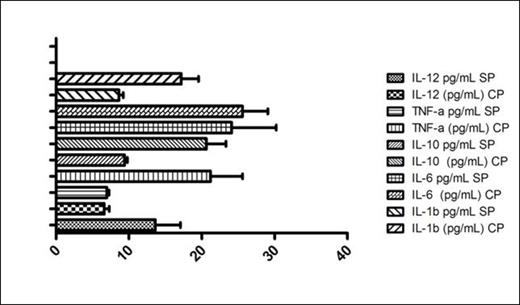Sickle cell disease (SCD) has a heterogeneous clinical picture, characterized by hemolysis, chronic inflammation and vaso-occlusive events and painful crisis.
Investigate the levels of Alpha 1 antitrypsin (A1AT), C reactive protein (CRP), hemolysis markers and its association with cytokines profile in SCD patients in steady-state and crisis-state.
It was developed a cross sectional study in a total of 72 SCD patients in steady-state (SP) and 23 SCD patients in crisis (CP) age-and-sex-matched. Hematological analysis was performed by automatic cell counter, hemoglobin profile by HPLC, and biochemistry analyses of inflammation and infection markers and lipid, hepatic, and kidney metabolism markers were investigated by immunochemistry assays. Plasma levels of TNFα, IFNγ, IL-10, IL-1β, IL-6 and IL-8 were measured using Cytometric Bead Array - CBA (BD Biosciences Pharmingen, USA) according to the manufacturer’s protocol.
Statistical analysis showed that SCD steady-state patients group had the highest IL-12 concentration (p<0.0001) and there were a decrease in TNFα, IL-10, IL-1β, and IL-6 levels (p< 0.0001) when compared to CP group (figure 1). However, significant differences in IL-8 levels were not finding in the comparison between SCD in steady-state and crisis patients groups. Biomarkers analyses of SCD steady-state patients showed significant negative correlation between IL-8 with A1AT (r= -0.25; p= 0.03) and CRP (r= -0.24; p= 0.04) and significant positive correlation with lactate dehydrogenase (LDH) (r= 0.25; p= 0.03). The IL-6 showed significant positive correlation with white blood cell count (WBC) (r= 0.52; p< 0.0001), ferritin (r= 0.30; p= 0.001) and CRP (r= 0.42; p= 0.0002). TNFα showed a significant positive correlation with leukocyte count (r= 0.28; p= 0.02) and A1AT (r= 0.29; p= 0.01) and IL-10 showed a significant positive correlation with platelets count (r= 0.30; p= 0.01) and A1AT (r= 0.29; p= 0.01).
Cytokine profile among steady-state and crisis SCD patients. Difference in cytokine levels comparing steady-state and crisis-state SCD patients.
Cytokine profile among steady-state and crisis SCD patients. Difference in cytokine levels comparing steady-state and crisis-state SCD patients.
Immunological aspects of SCD patients have been increasingly studied. The high levels of Th2 cytokines (IL-6 and IL-10) and proinflammatory cytokines (TNFα and IL-1β) in SCD patients in crisis-state, possibly is related to severe clinical manifestations, despite the fundamental role of these cytokines in the pathophysiology is not yet completely clear. The correlation between these cytokines and biomarkers associated with important clinical manifestations in SCD, such as WBC, platelet count, A1AT and CRP, highlights the important role of inflammatory mediators in SCD and its possible association with an expression or activation of adhesion molecules in neutrophils and vascular endothelium.
No relevant conflicts of interest to declare.


This feature is available to Subscribers Only
Sign In or Create an Account Close Modal